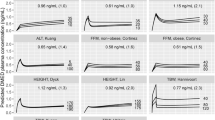Abstract
Provision of optimum comfort control to a critically ill child, in Pediatric Intensive Care Unit (PICU) requires a great degree of skill and planning and should be a prime concern for all practising paediatricians. Failure to provide adequate sedation and analgesia to control the stress response has been seen to be associated with increased complications and mortality. Sedation/analgesia in PICU is required both for, short term procedure and as an adjunct to pediatric intensive care. One has to identify the requirement whether sedation, analgesia or both. The ideal approach should be a sedative/hypnotic for sedation, an anxiolytic for anxiety, and an analgesic for pain. Threfore, it is essential, to provide the right drug for the problem at the right time in the right dosage. The drugs commonly used for sedation analgesia in PICU and their side effects have been described here.
Similar content being viewed by others
References
Anand KJS, Hickey PR: Pain and its effects in the human neonate and fetus.N Engl J Med 1987; 317(21): 1321–1329.
Walco GA, Cassidy RC, Schechter NL. Pain, hurt and harm. The ethics of pain control in infants and children.N Engl J Med 1994; 331(8): 541–544.
Little LA, Koenig JC, Newth CJL. Factors affecting accidental extubations in neonatal and pediatric intensive care patients.Crit Care Med 1990; 18 (2): 163–165.
Quinn MW 1. Effect of morphine and pancuronium on the stress response in ventilated preterm infants.Early Human Dev 1992; 30: 241–244.
American Academy of Pediatrics: Committee on drugs: Guidelines for monitoring and management of pediatric patients during and after sedation for diagnostic and therapeutic procedures.Pediatrics 1992; 89: 1110–1115.
Ewen A, Archer DP, Samanani Net al. Hyperalgesia during sedation: Effect of barbiturates and propofol in the rat.Can J Anesth 1995; 42: 532–540.
Maxwel LG, Deshpande JK, Wetzel RC. Pre-operative evaluation of children.Pediatr Clin North Am 1994; 41: 39–110.
American Academy of Pediatrics: Section on Anesthesiology. Evaluation and preparation of pediatric patients undergoing anesthesia.Pediatrics 1996; 98: 502–508.
Persson MP, Nilsson A, Hartwig P. Relation of sedation and amnesia to plasma concentrations of midazolam in surgical patients.Clin Pharmacol Ther 1988; 43(1): 324–326.
Brogden RN, Goa KL. Flumazenil: a reappraisal of its pharmacological properties and therapeutic efficacy as a benzodiazepine antagonist.Drugs 1991; 42 (6): 1061–1089.
Langlois S, Kreeft JH, Chouniard G. Midazolam; kinetics and effects on memory, sensorium and hemodynamics.Br J Clin Pharmac 1987; 23 (3): 273–278.
Holman GA. Analgesia and Sedation in Pediatric critical care. In: Fuhrman PB, Zimmerman JJ, editors, Pediatric Critical Care 2nd edn. 1998; 1363–1379.
Graham SR, Day RO, Lee R, Fulde JW. Overdose with chloral hydrate; a pharmacological and therapeutic review.Med J Australia 1998; 149: 686–688.
Mirenda J, Broyles G. Propofol as used for sedation in ICU.Chest 1995; 108 (2): 539–548.
Marx CM, Rosenberg DI, Ambuel D, Hamle KW, Blumer JL. Pediatric intensive care sedation; survey of fellowship programmes.Pediatrics 1993; 91(2): 369–378.
Berde CB, Lehn BM, Yee JD, Sethna NF, Russo D. Patient controlled analgesia in children and adolescents: a randomized prospective comparison with intramuscular administration of morphine for postoperative analgesia.J Pediatr 1991; 118(3): 460–466.
Gutstein HB, Johnson KL, Heard MB, Gregory GA. Oral ketamine pre-anesthetic medication in children.Anesthesiology 1992; 76(1): 28–33.
Tobias JD, Phipps S, Smith B, Mulhern RK. Oral ketamine premedication to alleviate the distress of invasive procedures in pediatric oncology patients.Pediatrics 1992; 90(4): 537–541.
Arrowsmith J, Campbell C. A comparison of local anesthetics for venepuncture.Arch Dis Child 2000; 82: 309–310.
Polaner DM. Sedation analgesia in the pediatric intensive care unit.Pediatr Clin North Am 2001; 48: 695–714.
Skogsdal Y, Eriksson M, Schoclin J. Analgesia in newborns given oral glucose.Ada Pediatr 1997; 86: 217–220.
Bless EM, Hoffmeyrlb. Sucrose as an analgesic for new born infants.Pediatrics 1991; 87: 215–218.
Chen E, Joseph MH, Zeltzer LK. Behavioral and cognitive interventions in the treatment of pain in children.Pediatr Clin North Am 2000; 47: 513–525.
Author information
Authors and Affiliations
Corresponding author
Rights and permissions
About this article
Cite this article
Nair, M.N.G., Jatana, S.K. Sedation analgesia in pediatric intensive care. Indian J Pediatr 71, 145–149 (2004). https://doi.org/10.1007/BF02723097
Issue Date:
DOI: https://doi.org/10.1007/BF02723097



